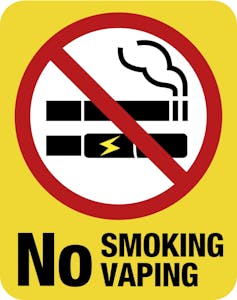
Elliott M. Reichardt, University of Calgary and Juliet R. Guichon, University of Calgary
Youth are using e-cigarettes (also known as vaping devices) at a rapidly increasing rate — a practice that constitutes an urgent threat to public health.
Preliminary survey data suggests that, for the first time in 30 years, the youth smoking rate has increased in Canada, with e-cigarettes being the suspected cause. Recent data from the Centers for Disease Control in the United States also found that 1.5 million more youth used e-cigarettes in 2018 than in 2017.
If unchecked by strict regulations, the next generation of youth is likely to be the most nicotine-dependent and the heaviest smoking in recent history, wiping out decades of efforts to protect them.
As researchers in tobacco control and pediatric bioethics, we seek to protect children and youth from lifelong nicotine dependency, initiation of cigarette use and the damage to lungs associated with e-cigarette use.
The most effective protection for children is evidence-based policy that addresses the reasons they start vaping. Advertising has been shown to promote a positive brand image for vaping devices and to spur youth to try them, while social media marketing has been linked to explosive growth in sales. Therefore, governments globally should promptly ban all e-cigarette advertising.
Governments should also mandate plain packaging for vaping devices, ban their use wherever tobacco use is banned and strictly limit the accessibility of sales to youth — placing e-cigarettes behind the pharmacy counter.
E-cigarettes are smoking initiation devices
Many people in the public health community had hoped that e-cigarettes would be an effective way for people to stop smoking (ourselves included). That’s because these battery-operated products deliver nicotine with fewer than the approximately 7,000 toxic chemicals in regular cigarettes.
However, e-cigarettes still contain potentially harmful substances — such as heavy metals like lead, volatile organic compounds and cancer-causing agents — and evidence of vaping being an effective cessation method is limited and, in many cases, ambiguous.
Research shows that most individuals (80 per cent) who attempt to quit smoking using e-cigarettes fail to do so. Of the 20 per cent who successfully quit smoking, most (80 per cent) remain active users of e-cigarettes.

The evidence also suggests that rather than being smoking cessation devices for adults, e-cigarettes act as smoking initiation devices for youth. The National Academy of Sciences’ systematic review published in early 2018 found substantial evidence that e-cigarette use increases the risks that youth and young adults will starting smoking cigarettes. It also found moderate evidence that vaping “increases the frequency and intensity” of subsequent cigarette smoking.
This finding has been affirmed in study after study published after the 2018 review. The increased risk of smoking is particularly strong (8.5-fold increased risk) in those who would otherwise be at low risk of starting to smoke cigarettes.
Marketing and “science” conspire

This pressing threat has been met with relatively muted concern. We don’t hear the fire alarms that should be sounding, perhaps because of the subversive social media marketing strategies pioneered by e-cigarette manufacturers — strategies that have created a social media landscape “dominated by pro-vaping messages disseminated by the vaping industry and vaping proponents.”
Using a cloud of misinformation, vaping companies have revolutionized the marketing of e-cigarettes and significantly increased youth vaping.
What’s more, the scientific research process can be corrupted. It is telling that studies published by the e-cigarette and tobacco industry are approximately 90 times more likely to find that e-cigarettes cause no harm than those published without such conflicts of interest.
The public needs clear, evidence-based information to address this emerging public health crisis.
Celebrity endorsements, gummy bear flavour
Communication to youth about the risks of e-cigarettes must address youth. Both youth and adults are attracted to e-cigarettes because they are thought to be cessation aids, to be a convenient way to avoid smoking laws and to be a safer alternative to smoking.
But e-cigarettes appeal to youth for additional reasons. Youth in particular are attracted to e-cigarettes because of their novelty, perceived harmlessness and multiplicity of flavours such as fruit, vanilla, chocolate and gummy bear.
Such appeal is actively cultivated by the e-cigarette industry through aggressive marketing campaigns that emphasize “lifestyle” and product design.
This marketing also occurs through successful engagement on Twitter, Instagram and YouTube, with online celebrity endorsements and by profiling a variety of smoke blowing “tricks.”
We reiterate that the most effective protection for children is evidence-based policy that addresses the reasons youth initiate e-cigarette use. To protect children, governments globally should promptly ban all advertising of e-cigarettes.
Vaping devices should also be sold in plain packaging, should be banned wherever tobacco use is banned and should be placed behind the pharmacy counter.![]()
Elliott M. Reichardt, Research Associate, University of Calgary and Juliet R. Guichon, Assistant Professor, Cumming School of Medicine, University of Calgary
This article is republished from The Conversation under a Creative Commons license. Read the original article.

